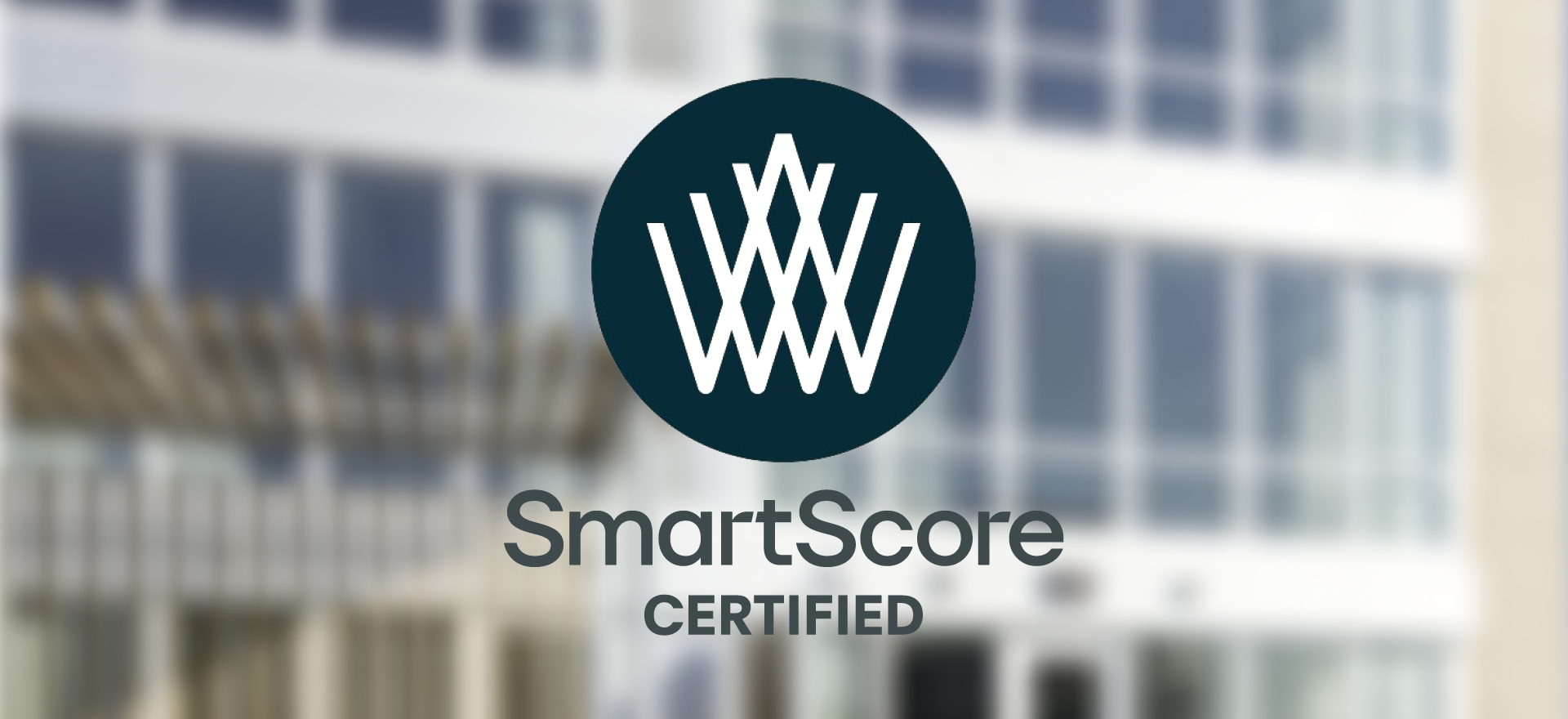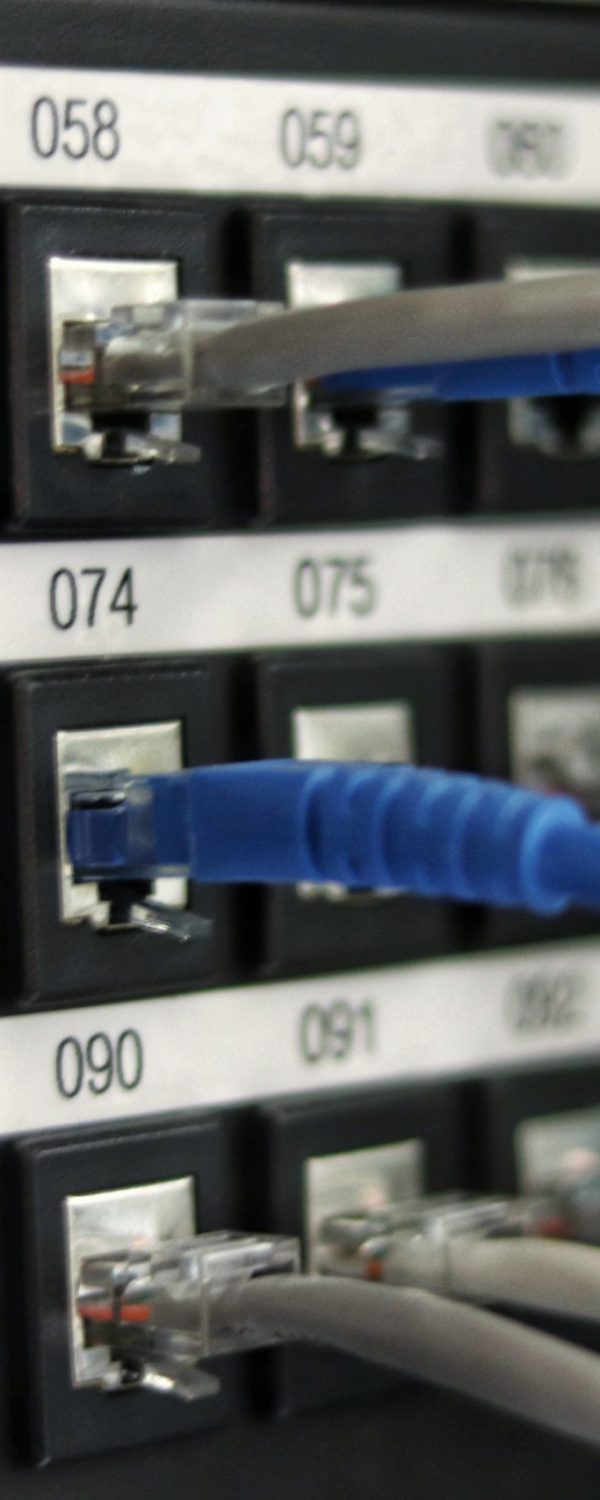What is SmartScore?

The Age of Smart Buildings
The architectural engineering and construction (AEC) industry is propelling commercial and multifamily real estate toward the age of “smart buildings.” Building automation systems, technological integrations, user data-gathering to drive optimized operational costs, and other functionalities tend to be inserted into the industry-wide discussion surrounding the standards that constitute a smart building. While all these technological components are incredibly helpful in pushing the industry forward, many design professionals have stopped to consider what makes a smart building…smart. WiredScore, the founders of the global commercial real estate certification system defining excellence in digital connectivity, have created what they intend to be the global standard for rating and certifying smart buildings–SmartScore.
According to the official WiredScore website, SmartScore measures how buildings integrate digital technology to evolve a tenant’s experience within a structure using two main points of criteria: User functionality and technological foundation. As of 2023, only 13 buildings within the United States have officially received SmartScore certification.
In essence, the user functionality portion of the SmartScore “scorecard” measures the structure’s current suite of technological amenities and how they service the building users and building operators. User functionality measures a building’s ability to provide optimized access and navigation, tenant health and wellbeing, sustainability, community services, ease of maintenance and operations, and safety. The technological foundation section of SmartScore assesses a building’s ability to keep pace with future smart integrations and technology. The three categories that the technological foundation section measures include building systems interoperability, cybersecurity, and building data management.


Certifiably Smart
The SmartScore rating system is still in the early stages of nationwide integration. SmartScore was officially released on April 20, 2021, and there are a lot of questions developers and architects have concerning the feasibility of pursuing SmartScore while carving out the vision of their future space. Fortunately, IP Design Group’s consultants can help clarify the intricacies of SmartScore ratings and provide consultation on projects that are interested in pursuing a SmartScore certification. Cameron Gilinsky, P.E., RCDD, CTS-D, WiredScore AP, SmartScore AP, and Dalton Rabe, WiredScore AP, SmartScore AP, are part of IP Design Group’s technology systems design team and understand the complexities of SmartScore and how to implement smart technology strategies into new construction and renovation projects.
“WiredScore certification is focused on a building’s ability to provide resilient and cutting-edge network infrastructure to tenants,” Cameron explains, “Whereas SmartScore is focused on a user’s in-building experience and how the smart technology that has been integrated into the building helps to enhance that experience.”
The corporate office market sector is a primary target for SmartScore certification as building owners attempt to increase their in-office value proposition as a two-fold front that competes with the work-from-home movement as well as utilizing their building as a recruiting tool that attracts new talent. Dalton thinks there are implications for additional market sectors to be involved as SmartScore becomes more widespread.
“Luxury residences and hotels could potentially be emerging market sectors where a SmartScore certification would carry a lot of weight,” Dalton explains, “SmartScore really focuses on measuring how an in-building experience can be catered to user preference, which aligns with current design trends in high-end hotels and apartments that focus on a customized guest experience.”
Future technology could allow hotels to save guest room preferences. Upon a guest’s arrival, entering check-in information into the hotel management system software can trigger a building automation system protocol that sets their room to their desired temperature along with activating the lights, flipping on the television, and prepping their stay all before a guest reaches their room and unlocks the door. This is one of many possible avenues that hospitality, multifamily, and commercial offices can explore to help tenants and users feel more comfortable and secure inside their spaces.
A Consultant’s Role in Achieving SmartScore
The challenge with achieving a SmartScore certification lies in creating an interconnected network of systems that are built with future integrations in mind to allow a building to stay on the cutting edge of smart capabilities. These systems need to have the ability to communicate effectively with one another and coordinate sequenced protocols (i.e., lights adjust as shades are lowered). According to our technology systems team, system intercommunication requires an added level of collaboration with other AEC disciplines, more so than ever before.
“A building automation system (BAS), for example, has traditionally been handled by the mechanical engineering discipline on a project as its job is to control the amount of fresh air that comes into a building and adjust the temperature along with other HVAC controls. For smart buildings, the BAS now has the ability to communicate with the lights, the automated shades, and whatever other additional components that building owners want to account for,” Cameron explains, “The network systems that technology consultants design are the backbone of these interconnected networks, it’s our job to provide them with the infrastructure they can use to communicate with each other.”
To create a high-performing design, our technology consultants’ responsibility involves collaborating with every entity that will be either designing or installing components that utilize the building’s system of networks. Our consultants identify and create multiple efficient pathway routes with added space to integrate larger network cables to ensure a structure’s smart components are equipped with proper data-sharing capabilities for future renovations.
“It can be difficult to predict what the network and technology needs of the future are going to look like,” Dalton explained, “Our team can design areas that are ‘future-proofed’ by allowing for additional space in cable raceways as well as designing server rooms to be able to house additional equipment and cable trays if the building owner decides they want to add more network capabilities in the future.”
Our firm’s technology consultants also assume an advisory role for building owners in order to help them develop their technology roadmap. This roadmap outlines a client’s desired technology initiatives, which our team supplements with information regarding the infrastructure necessary to achieve said initiatives. That being said, a building owner and operator is concerned with achieving this outcome without allocating a disproportionate amount of budget to execute. Due to the rapidly changing nature of in-building technology, many owners are simply unaware of all the technology options at their disposal and what they can pursue based on cost.
“Cost is the number one barrier for building owners,” Dalton explained, “A lot of clients have a laundry list of functions and components they want to include, so we show them how we’d design it and the cost it would accrue, and sometimes they’ll have to change course and restructure the number of technological amenities they want their building to feature.”

Considering SmartScore?
While the initial cost for construction and project delivery with smart building capabilities can be higher than a typical building project, our consultants emphasize that SmartScore’s focus on future outcomes and return on investment for building owners are ideas every client should consider before moving forward with design.
“The SmartScore rubric puts a lot of emphasis on measuring your building’s energy outputs and getting the most out of energy spent on a day-to-day basis,” Dalton concludes, “They argue that by monitoring and optimizing electrical and mechanical loads, the amount of money a building owner saves in energy spending counterbalances the initial construction cost, and there’s a lot of merit to that.”
The most recent iteration of the SmartScore scoring guidelines also awards certification points for creating seamless and easy-access wayfinding capabilities for neurodivergent individuals who may have difficulty or anxiety when it comes to navigating unfamiliar spaces.
“SmartScore incentivizes building managers to utilize eco-friendly technology design strategies that are inclusive of a wide demographic,” Cameron concludes, “That’s a good thing. Buildings built for the future should be built for everyone and should consider health, wellbeing, and sustainability.”
Interested in learning more about feasible SmartScore applications? We’d love to connect you with our technology consultants.

Cameron Gilinsky, P.E., RCDD, CTS-D, WiredScore AP, SmartScore AP
Cameron Gilinsky is a technology systems designer who has been with the firm since 2019. Cameron specializes in telecommunications and wireless network designs for market sectors including higher education, commercial office, corporate headquarters, and more.

Dalton Rabe, WiredScore AP, SmartScore AP
Dalton Rabe is a technology systems designer who has been with the firm since 2020. Dalton specializes in technology design and has been involved in some of IP Design Group’s most technically complex projects including the 8111 Douglas mixed-use development, Circle South office tower, and the Union Bank & Trust office complex.


